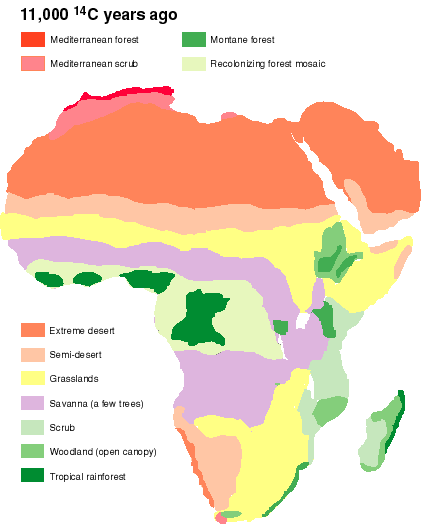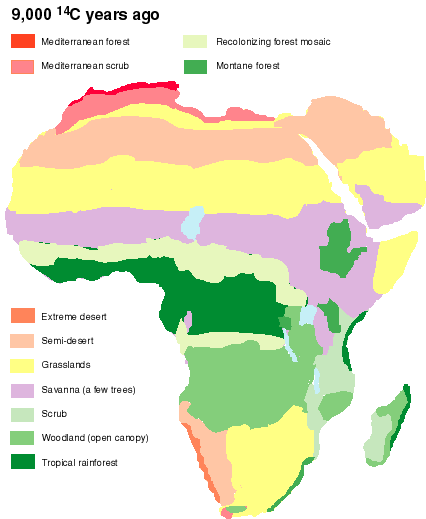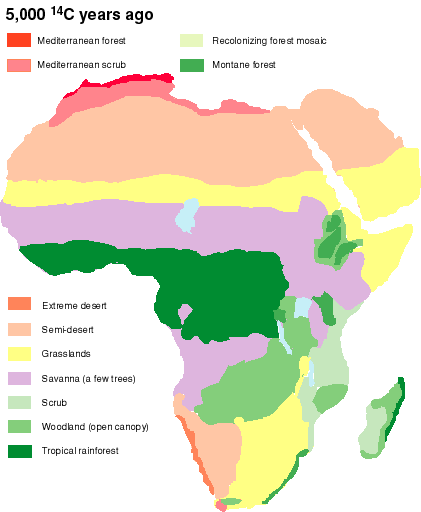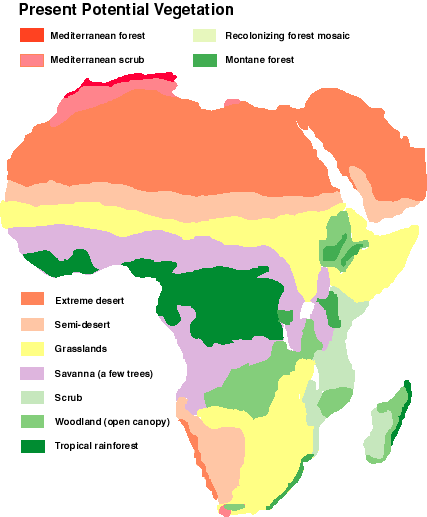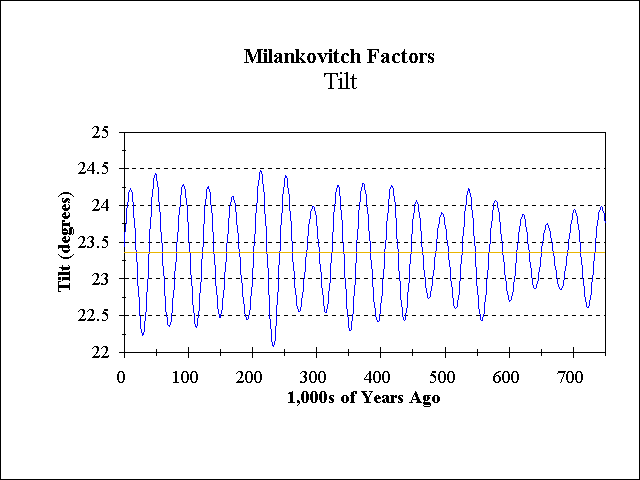
|
 EgyptSearch Forums EgyptSearch Forums
  Ancient Egypt and Egyptology Ancient Egypt and Egyptology
  Africa climate history. Africa climate history.
|
| next newest topic | next oldest topic |
| Author | Topic: Africa climate history. |
|
rasol Member Posts: 3041 |
  
Africa 22 thousand years ago: 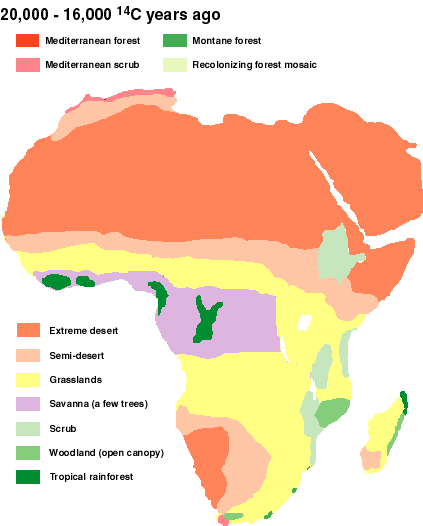 Africa 11 thousand years ago: Africa 09 thousand years ago: Africa 05 thousand years ago: Africa currently
130,000 years ago, a warm phase moister than the present began, and this lasted until about 115,000 years ago, with greater rainforest extent and the deserts almost completely covered with vegetation. Subsequent cooling and drying of the climate led to a cold, arid maximum about 70,000 years ago, followed by a slight moderation of climate and then a second aridity maximum around 22,000-13,000 14C years ago. Conditions then quickly became warmer and moister, though with an interruption by aridity around 11,000 14C years ago. A resumption of warm, moist conditions led up to the Holocene 'optimum' of greater rainforest extent and vegetation covering the Sahara. Conditions then became somewhat more arid and similar to the present. Relatively brief arid phases (e.g. 8,200 14C y.a.) appear to punctuate the generally moister early and mid Holocene conditions. IP: Logged |
|
rasol Member Posts: 3041 |
  
source: http://www.esd.ornl.gov/projects/qen/nercAFRICA.html IP: Logged |
|
rasol Member Posts: 3041 |
  
The primary habitat for homo sapiens throughout African history has been the savanna grasslands. (yellow and purple) Observe that grassland stretches from west coast to east coast, always has. The latitude and extent of it expands and contracts as the climate cycles over and again thru wet and dry phases, but east and west Africa have never been substantially cut off from one another. [This message has been edited by rasol (edited 14 March 2005).] IP: Logged |
|
Super car Member Posts: 930 |
  
Earlier it was thought that Homo Sapiens Sapiens appeared around 150, 000 years ago. Further studies show that they may well have been around 200,000 years ago. In light of what you posted earlier (provided below), what should be said about the climatic conditions during 200,000 years and how this affects the evolutionary process of humans? One would think that the climatic conditions influencing the evolutionary process would start little over the timeframe set for anatomically modern humans, wouldn't say? East Africa is notorious for its mountainous regions.
quote: [This message has been edited by Super car (edited 15 March 2005).] IP: Logged |
|
rasol Member Posts: 3041 |
  
quote: What should be said is that climate varies everywhere and the variations involve many complex interrelated cycles, which are in turn related to ocean currents, orbital axes variation, release of carbon dioxide from volcanos and many other phenomena. However, tropical regions such as Africa do not vary as wildly over time as do northerly climes such as North America or Europe. Europe and North America vacilate between being largely ice covered wastelands to milder more temperate zones. Africa varies largey in that the deserts, grasslands and rainforests spread, and retreat, with human populations expanding and retreating along with it. During the last wet phase about 10,000 years ago much of the sahara was fertile, with crocodiles, giraffes, lakes and substantial human populations as well. The drying of this area is likely one of the factors that caused populations to converge into the Nile Valley and also expand across the Levant. Populations in Africa respond to climate change primarily by migrating. The precursors of the indigenous somatic variations that exist in Africa today have existed for many 10's of thousands of years because the same range of climate variation has exited during this time, and repeated over and again. And of course this is notwithstanding the climatic constant of tropical solar radiation, to which native African dark skin tone is adapted. The situation in Europe could not be more different.... About 24,000 years ago, the last ice age began, with mountain-sized glaciers moving across most of Europe. Paleolithic Europeans retreated before the ice, finding refuge for hundreds of generations in three areas: what is now Spain, the Balkans and the Ukraine. - PA Underhill. [This message has been edited by rasol (edited 15 March 2005).] IP: Logged |
|
rasol Member Posts: 3041 |
  
Solar Activity and Ice Ages, causes and relevance to African morphology. There are 3 principal factors directly effecting the amount of energy the earth gets from the sun. The solar cycle, orbital eccentricity and, perhaps the most important... orbital tilt.
The smaller the tilt in the Earth's axis...the more solar energy is received in TROPICS, and less in the mid and high latitudes. It is this condition that is one of many interrelated culprits in triggering ICE AGES. 25 thousand years ago the Earth's axis tilt was near it's minimum. This means Northern EurAsia may have recieved less UV at this time, but tropical East Africa may have actualy recieved more. Pale skin tones developed in Eurasia at around this time. In tropical Africa, pale skin is and always has been maladaptive (ie = skin cancer). Native tropical Africans have dark skin for this reason and always have- throughout the entire history of modern human evolution from 150kbp until today.
IP: Logged |
|
Super car Member Posts: 930 |
  
Good replies. IP: Logged |
|
rasol Member Posts: 3041 |
  
The Earth's orbit is elliptical and also changes from a more oval shape to a more circular one over time. Apehelion - when the earth is furthest from the sun. Perhelion - when the earth is closest to the sun. Presently the perhelion occurs in January and apehelion in July. To those living in the Northern Hemisphere this may seem odd, but this actually makes the seasonal extremes in the Northern Hemisphere less severe and those in the Southern Hemisphere more severe. 10 thousand years ago, the reverse was the case, 20 thousand years ago, it was as it is now.
Each of these phenomena have a different time scale and so a complex relationship on the earth's climate, often effecting the northern vs. southern hemishere and the topics vs. the high latitudes, in opposite ways, and with a minimal effect on actual UV sometimes having a major impact on climate especially in Northern Eurasia. Africa's native peoples are primarily adapted to a high UV environment with differing ranges of savanna grassland, desert and rainforest. [This message has been edited by rasol (edited 16 March 2005).] IP: Logged |
|
rasol Member Posts: 3041 |
  
9000 years ago grassland extended north in Africa all the way up thru Nubia to what is now southern Egypt.
[This message has been edited by rasol (edited 20 March 2005).] IP: Logged |
|
Super car Member Posts: 930 |
  
Sub-Sahara, though really a geographical term, has become politicized to mean something other than that. Again, mainly the development of 19th century European approach to scholarship. In fact, Egypts history, not to mention the linguistic ties of North African territories, belies intentions behind the politicized use of the term. In bio-anthropology and linguistics, so long as it is used in its proper geographical context and in a consistent manner, there should be no problem. IP: Logged |
|
kifaru Member Posts: 82 |
  
quote: Thank you for making this point. I am always somewhat amazed by the fact that people believe that africans cannot now or could not then travel long distances or traverse hostile terrain of their own volition. IP: Logged |
|
rasol Member Posts: 3041 |
  
quote: It is also interesting to consider, in terms of defining Africa by geography and then by ethnicity....where exacty does East Africa end and west Africa begin, and why...based on what geographic feature, cultural facet, genotype or physical feature? In truth you are likely to find affinity on all fronts from East to West for reasons shown on the above climate maps. However since anthropology revealed the rift valley origins of humanity, the tendency has been to attempt to remove East Africa...from Africa. And many misguided studies on Africa and its peoples have, by design, and consciously or not, tended to conceptually replicate that ideological bias. IP: Logged |
|
rasol Member Posts: 3041 |
  
quote: Thought Posts:
IP: Logged |
|
Thought2 Member Posts: 1491 |
  
quote: Thought Writes: The important thing about this study is that it demonstrates the flaws in the "agricultural revolution" theory as espoused by Gordan Childe. Childe argued that agriculture and animal husbandry led to sedentism and sedentism led to an urban revolution. This urban revolution in turn led to social complexity or "civilization". Of course we now know that some groups like Africans in Early Khartoum have been sedentary since the early Holocene but did not develop hierarchical complex political structures. Likewise central and northern Europeans practiced village based agriculture earlier than Africans outside the Nile Valley, yet they NEVER developed hierarchical complex political structures they simply received these structures from Rome. Populations in the Saharan Neolithic practiced a semi-sedentary wild grain using transhumance based lifestyle, yet they also developed hierarchical complex political structures as evidenced by the burial of elites throughout the Sahara. This political substructure was infused and elaborated on in Ancient Egypt. The key seems to be economies based upon agriculture and/or animal husbandry effected by extreme environmental constraints. Agriculture and/or animal husbandry produce unequal wealth accumulation. Environmental stress adds hierarchical complexity to this economic and political structure. IP: Logged |
|
windstorm2005 Member Posts: 32 |
  
Excellent thread! ...What about what Europe was like during corresponding periods? IP: Logged |
|
Super car Member Posts: 930 |
  
quote: ?? [This message has been edited by Super car (edited 27 March 2005).] IP: Logged |
|
rasol Member Posts: 3041 |
  
About 80 percent of Europeans arose from primitive hunters who arrived about 40,000 years ago, endured the long ice age and then expanded rapidly to dominate the continent, a new study shows. About 24,000 years ago, the last ice age began, with mountain-sized glaciers moving across most of Europe. Underhill said the Paleolithic Europeans retreated before the ice, finding refuge for hundreds of generations in three areas: what is now Spain, the Balkans and the Ukraine. When the glaciers melted, about 16,000 years ago, the Paleolithic tribes resettled the rest of Europe. Y chromosome mutations occurred among people in each of the ice age refuges, said Underhill. He said the research shows a pattern that developed in Spain is now most common in northwest Europe, while the Ukraine pattern is mostly in Eastern Europe and the Balkan pattern is most common in Central Europe. About 8,000 years ago, said Underhill, a more advanced people, the Neolithic, migrated to Europe from the Middle East, bringing with them a new Y chromosome pattern* and a new way of life: agriculture. About 20 percent of Europeans now have the Y chromosome pattern from this migration, he said. In general, studies show that modern humans first arose in Africa about 100,000 years ago and thousands of years later began a long series of migrations, he said. Some groups migrated eastward and humans are known to have existed in Australia about 60,000 years ago. Other groups crossed the land bridge into the Middle East. Humans appeared in Central Asia about 50,000 years ago. From there, the theory goes, some migrated west, arriving in Europe about 40,000 years ago IP: Logged |
|
Thought2 Member Posts: 1491 |
  
quote: Thought Writes: Simple hunters and gathers until the spread of the neolithic from Africa via the Near East. IP: Logged |
|
rasol Member Posts: 3041 |
  
quote: IP: Logged |
|
rasol Member Posts: 3041 |
  
quote: IP: Logged |
|
rasol Member Posts: 3041 |
  
The Holocene Climate Optimum warm event consisted of increases of up to 4 °C near the North Pole (in one study, winter warming of 3-9°C and summer of 2-6°C in northern central Siberia. Northwestern Europe experienced warming, while there was cooling in the south. The average temperature change appears to have declined rapidly with latitude so that essentially no change in mean temperature is reported at low and mid latitudes. Tropical reefs tend to show temperature increases of less than 1 °C. In terms of the global average, the typical shift was probably between 0.5 and 2 °C warmer than the mid-20th century (depending on estimates of latitude dependence and seasonality in response patterns).
By 6,000 years ago, the time normally associated with the Holocene Climatic Optimum in the Northern Hemisphere, these regions had reached temperatures similar to those existing in the modern era, and did not participate in the temperature changes of the North. However, some authors have used the term "Holocene Climatic Optimum" to describe this earlier southern warm period as well. While there do not appear to have been significant temperature changes at most low latitude sites, other climate changes have been reported. Since there is no scientific consensus on how to reconstruct global temperature variations during the Holocene IP: Logged |
|
rasol Member Posts: 3041 |
  
quote: http://www.esd.ornl.gov/projects/qen/new_africa.html [This message has been edited by rasol (edited 08 May 2005).] IP: Logged |
|
rasol Member Posts: 3041 |
  
 Cave painting from Northern Algeria - 6000 BC [This message has been edited by rasol (edited 08 May 2005).] IP: Logged |
All times are GMT (+2) | next newest topic | next oldest topic |
  |
|
Contact Us | EgyptSearch!
(c) 2003 EgyptSearch.com
Powered by Infopop www.infopop.com © 2000
Ultimate Bulletin Board 5.45c
